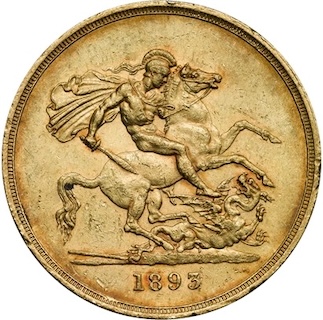
Home | Gold 5 Pound Coins | 1893 Gold 5 Pound Coins - Victoria
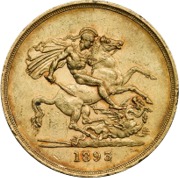 The 1893 Gold 5 Pound Coins - Victoria
The 1893 Gold 5 Pound Coins - VictoriaA gold £5, 5-sovereign coin. A large coin containing 39.9 grams of 22K Gold. This coin is graded as VF. SCBC 3872.
The Reverse shows Benedetto Pistrucci's St George and the Dragon.
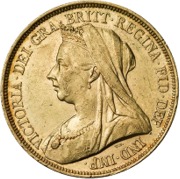 The Obverse shows a old-head or veiled head portrait of Queen Victoria. It was the first time the old head design, by Sir Thomas Brock, had been used.
The Obverse shows a old-head or veiled head portrait of Queen Victoria. It was the first time the old head design, by Sir Thomas Brock, had been used.Images used by permission of The Royal Mint
Mintage: 20,405 (may include coins in sets)
Minted at The Royal Mint
More information (monarch, year, mint, country, category) can be found below coin listings.
Below are some coins currently being offered on eBay. As an eBay Partner, We may be compensated if you make a purchase.
List items on:
 | 1893 GREAT BRITAIN VICTORIA GOLD 5 POUNDS £ 8,000.00 |
List items on:
Remember 1893 ?
Monarch is Queen Victoria. Prime Minister is William Ewart Gladstone (Liberal). US President is Benjamin Harrison (R-Indiana), then on 4th March it is Grover Cleveland (D-New York). First British Ladies Amateur Golf Championship (at Royal Lytham & St Annes).
Victoria (1837-1901)
Victoria was Queen of the United Kingdom of Great Britain and Ireland from 20 June 1837 until her death. From 1 May 1876, she adopted the additional title of Empress of India. Victoria ruled for 64 years, a record only recently surpassed by Queen Elizabeth II.Victoria's parents were Prince Edward, Duke of Kent and Strathern, and Princess Victoria of Saxe-Coburg-Saalfeld. She married Albert of Saxe-Coburg and Gotha, who later became known as Prince Albert. Victoria had nine children, the eldest son succeeding her as Edward VII.
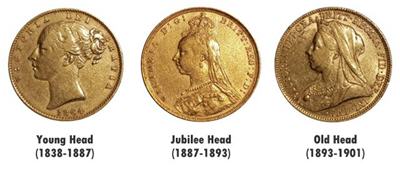
Victoria posed for a number of head portraits, but there are generally three major variants: Young Head (1838-1887) by William Wyon, RA; Jubilee Head (1887-1893) by Sir Joseph Edgar Boehm and Old Head (1893-1901) by by Sir Thomas Brock.
Category: Gold 5 Pound Coins
Not that many people own Gold Five Pound coins, I suppose mainly because they are an expensive coin even in bullion form. Perhaps even fewer realise there are two basic kinds of gold five pound coin. They are very similar, yet distinct. The Gold £5 Coin
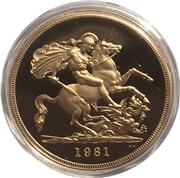
Often referred to as the non commemorative £5 coin or the Quintuple Sovereign as it is exactly five times heaver than a Sovereign (7.9881 x 5 = 39.94g). As one sovereign is nominally one pound then a quintuple sovereign must be five pounds.
The Gold £5 coin has its history deriving from the five guinea coin right back at the start of the 19th Century. In those days a guinea was valued at one pound rather than the one-pound-and-one-shilling it is often remembered as nowadays. George III, George IV and Victoria all issued actual gold £5 coins and others issued a few too, but Elizabeth II began the surge in production, especially from 1980 onwards. From 1990, the £5 coin was minted in Cupro-Nickel too and silver versions were also available.
The Gold Crown
The Crown is another English coin with a long history. You may remember the Half-Crown from pre-decimalisation days, but the Crown has been a commemorative coin for as long as we can remember. The Crown was legal tender at a quarter-pound, which was five shillings (25 pence in decimalised money).
In the Eighties we saw the introduction of the pound coin and the two-pound coin, so the Government decided that the crown needed to be restored to it former glory as biggest denomination coin and the crown was re-denominated to £5 in 1990.
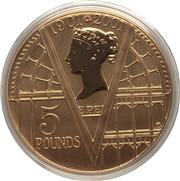
This re-denominated was OK by itself, but as a (still) mainly commemorative coin it was soon available not only as Cupro-Nickel but as silver and ... gold. That meant we had a new, official, gold £5 coin.
It also weighs 39.94g. And to prove its value it has '5 pounds' written on it.
The only difference between the sovereign gold £5 coin and the gold crown is the diameter. The crown maintained its original diameter of 38.61mm compared to the slightly smaller 36.613mm of the sovereign type.
The re-denominated had other effects too. Whether re-denominated is determined as from this point onwards or backward-compatible is unclear to many. The original crown was a gold coin, so does that mean that Henry VIII's gold crowns were the first £5 coins? So the history of coins starts to rewrite itself in some ways, although if this is intended or correct I'm not sure.
The Gold Five-Pound Piece
I've noticed many dealers referring to these coins as '£5 pieces'. Maybe it's a way of avoiding the confusion and grouping the coins into the same category rather than having them as two separate entities. Besides the slight difference in diameter (which is difficult to see as most of these coins are encapsulated in some way) there's little to tell.
If the reverse looks like it commemorated something then it's probably a crown. If the reverse is the same as the reverse of a sovereign of the same year then it could be a five pound coin. Whatever, you have a gold five pounds with almost 40g of gold; it's impressive and they are a great investment.
Five pound coins are often in 4- or 5-coin sets, together with combinations of a sovereign, half-sovereign, double sovereign, quadruple sovereign and maybe some commemorative item or a year-set collectable. They can be bullion, proof or matt-proof.
Despite the high intrinisic value and even higher collector value, five pound pieces are much sought after and are often sold out within days of release causing some of the coins to have a very high price tag.
Which Mint: The Royal Mint
The Royal Mint is the designated place for the UK to mint coins. It dates back well over 1000 years and is a Government-owned company. Formed in the reign of Alfred the Great about the year 886, during the period 1279-1812 it was generally referred to as The Tower Mint as it was housed at the Tower of London. The Master of The Royal Mint has included famous figures such as Sir Isaac Newton.
Since 2010 it has operated as Royal Mint Ltd, a company owned by HM Treasury, under an exclusive contract to supply all coinage for the UK although it also produces medals and coins for other countries. It is currently located at Llantrisant, Wales.
Country of Origin: United Kingdom
The United Kingdom (UK) is the Union of England, Scotland, Wales and Northern Ireland. It is often refered to as Great Britain (GBR). It has a long, rich history. The orignal coinage was Pounds, Shillings and Pence but since decimalisation on 15 February 1971, it is £1 = 100p, that is One Pound = 100 pence. The coinage of the UK is also a long history, the Royal Mint being established as long ago as 886AD when coins were hammered. Today there is perhaps 30 billion coins in circulation, and many (numismatic) collectors coins and sets are issued frequently in gold, silver and other metals.
Try the Gold 5 Pound Coins page on eBay UK
As an eBay Partner, We may be compensated if you make a purchase.
As an eBay Partner, We may be compensated if you make a purchase.
